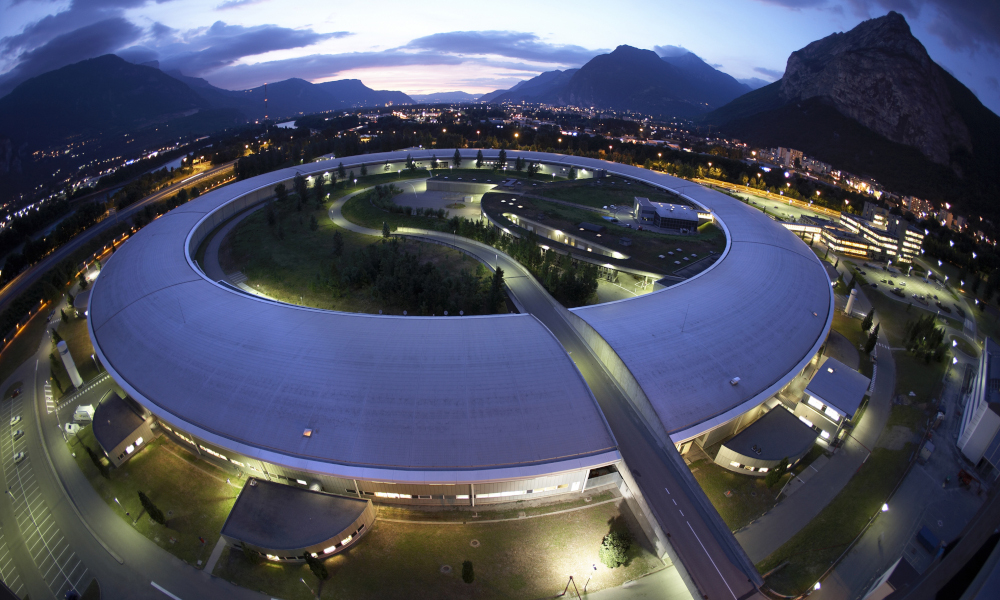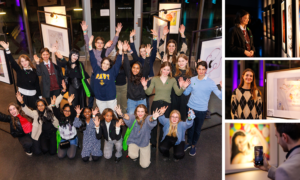
Upgraded beamlines at EMBL Grenoble unveiled
The beamlines run jointly by EMBL Grenoble and the ESRF reopen today, unveiling significant upgrades that exploit the brand new fourth generation ESRF synchrotron source.

Inside the European Synchrotron Radiation Facility (ESRF)’s 844 m diameter storage ring, electrons travelling at almost the speed of light produce some of the brightest X-ray beams in the world. These X-rays can reveal the position and motions of atoms in all kinds of matter. Seven of the facility’s 44 beamlines are dedicated to structural biology research and run under the auspices of an EMBL-ESRF partnership known as the Joint Structural Biology Group (JSBG). The macromolecular crystallography (MX) and small angle scattering beamlines are operated by scientists from both institutions, who use their expertise to help EMBL researchers and visiting scientists obtain structural data. The JSBG beamlines are an extremely valuable resource for the international structural biology community.
A long-awaited opening
More than a year and a half ago, the ESRF was shut down for 20 months, during which time the synchrotron ring was completely rebuilt and upgraded into the world’s first Extremely Brilliant Source (EBS) – a €150 million project that runs from 2017 to 2022. Shortly after the new ring was completed in January 2020, X-rays were routinely being produced again.
“It was amazing that once the new synchrotron was operational, we had the beam back and data collection up and running in three days!” says Matthew Bowler, from the McCarthy Team at EMBL Grenoble, and one of the scientist responsible for one of the JSBG beamlines.
After a successful start to commissioning, the ESRF-EBS – and with it the beamlines – had to remain closed once again because of the COVID-19 pandemic. During the last months, exceptional access was only granted to a few users with projects that contributed to the international scientific effort on the research on COVID-19.
With the opening today, the innovations brought about by the EBS project are finally being unveiled to the scientific community. Apart from the construction of a new storage ring, they include an advanced instrumentation upgrade programme, and improvement of all the JSBG’s structural biology beamlines, notably a significant upgrade of MASSIF-1.
A greater level of automated science
MASSIF-1 is one of the seven beamlines run jointly by the ESRF and EMBL Grenoble, and was the world’s first automated beamline. Matthew Bowler, and Didier Nurizzo from ESRF, explain the advantages of the procedure: “The beamline works 24 hours a day. Researchers send their frozen crystals by mail, and the beamline scientists load them into a large capacity cryogenic storage system. The samples are then analysed by the beamline completely automatically.”
This process involves a robot taking the crystal from the storage into the beam, then complex algorithms locate the sample and decide the optimal experimental protocol. Once analysis starts, the users receive an email and can see their data being collected remotely and in real time.
“The automation is fantastic,” concludes Bowler. “It will do the same job for every sample, whether it’s four o’clock in the afternoon or in the morning.”
During this year several important upgrades are being implemented on MASSIF-1. For example, an EMBL-developed microdiffractometer – an instrument that can place and rotate a crystal in the X-ray beam with an accuracy of one thousandth of a millimetre – has just been installed. At a later stage the optics that focus the X-rays onto the crystal will be adapted to the new beam produced by the EBS, which is 100 times brighter than the previous beam.
One of the most important upgrades for the beamline will be the introduction of the FlexHCD robot. This robot was jointly developed by the Ciprani Team, EMBL Grenoble’s Instrumentation team, and the ESRF Instrumentation Services and Development Division and Structural Biology groups. This new frozen crystal handling device will substantially increase the speed of data-gathering. “At the moment, up to six minutes are needed per sample,” explains Nurizzo. “The upgrade will double or triple the processing speed.”
New experimental opportunities
Before crystals can be analysed at JSBG beamlines, they need to be generated at a crystallisation facility through a thorough and sometimes tedious process of screening and optimization, which typically takes many times longer than the diffraction experiments themselves.
Another important upgrade involves the CrystalDirect robot, which was developed in 2012 by the Cipriani Team and the Marquez Team at EMBL Grenoble. This technology enables full automation of crystal mounting and cryo-cooling, facilitating the transfer of samples between the crystallisation facility and the synchrotron.
In its new form, MASSIF-1 will be operated in coordination with the EMBL HTX Lab, which will bring a new level of efficiency, particularly in intensive fragment screening campaigns for drug discovery. Moreover, during 2021, one of the CrystalDirect robots from the HTX Lab will be integrated into the MASSIF-1 beamline environment. This will be a major step forward and enable delivery of samples directly from the crystallisation plate into the X-ray beam. All these developments will maintain EMBL and ESRF at the forefront of innovations in MX beamline technology in the world for the benefit of structural biology.


